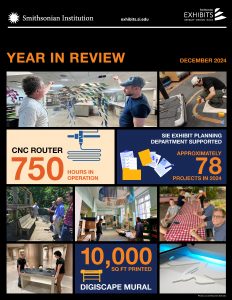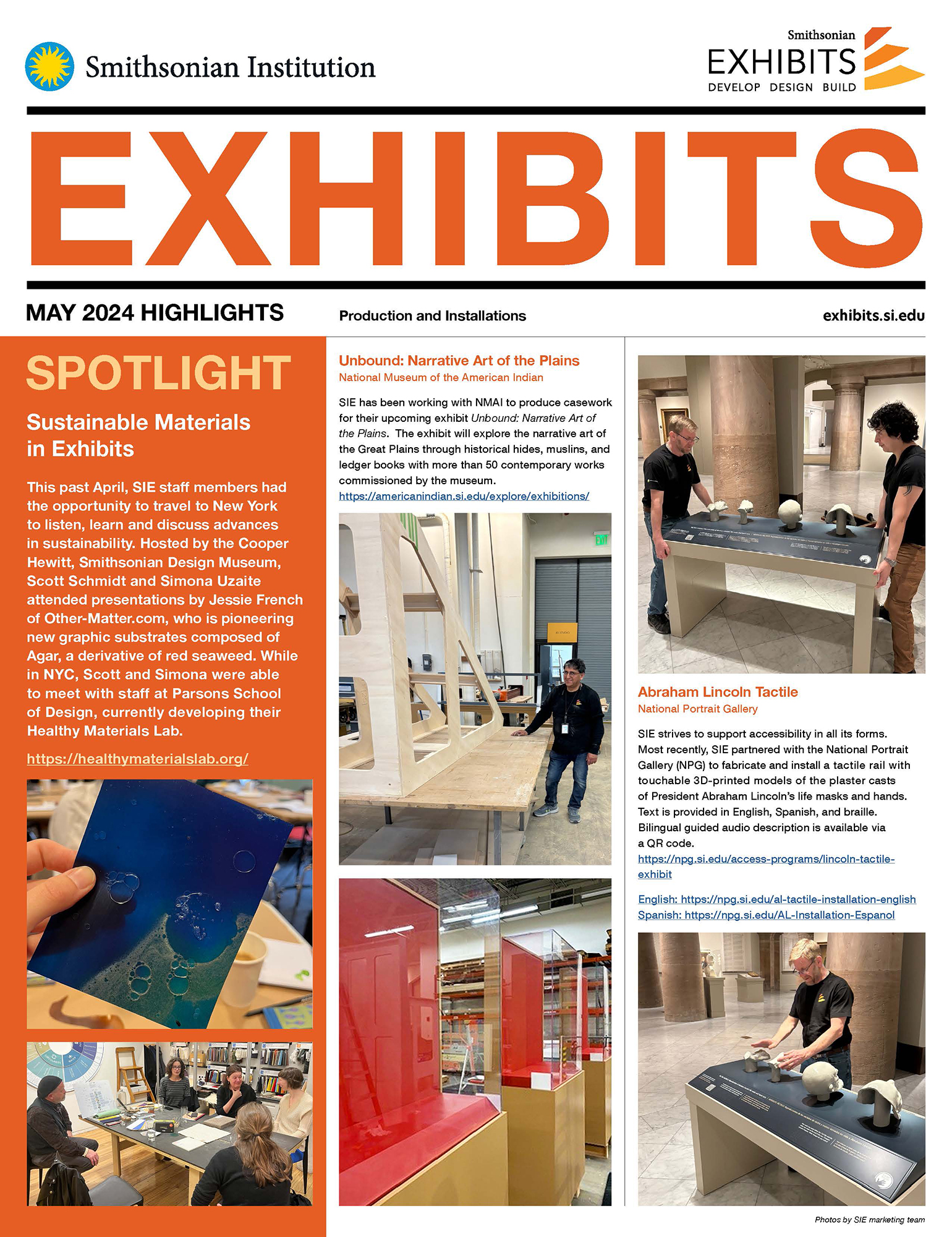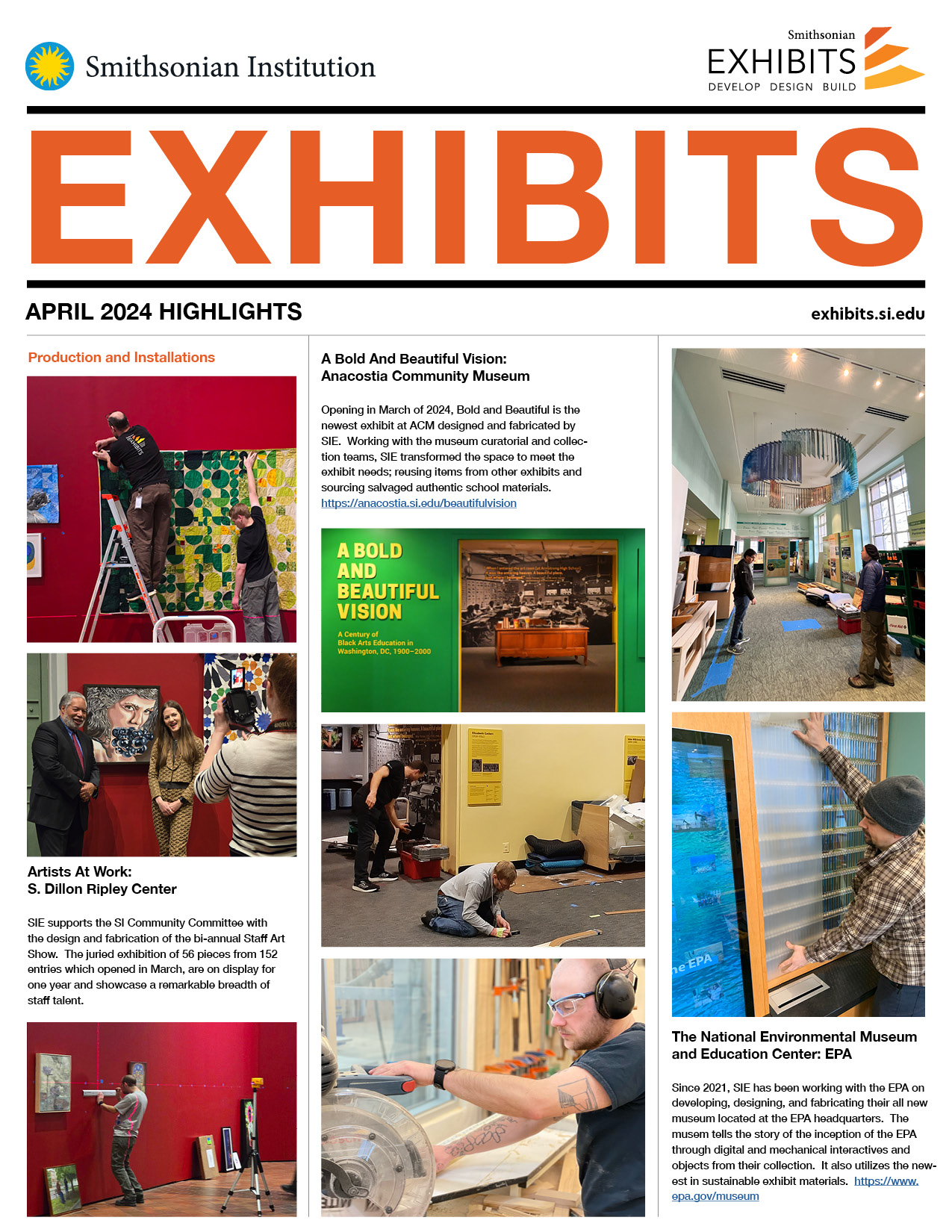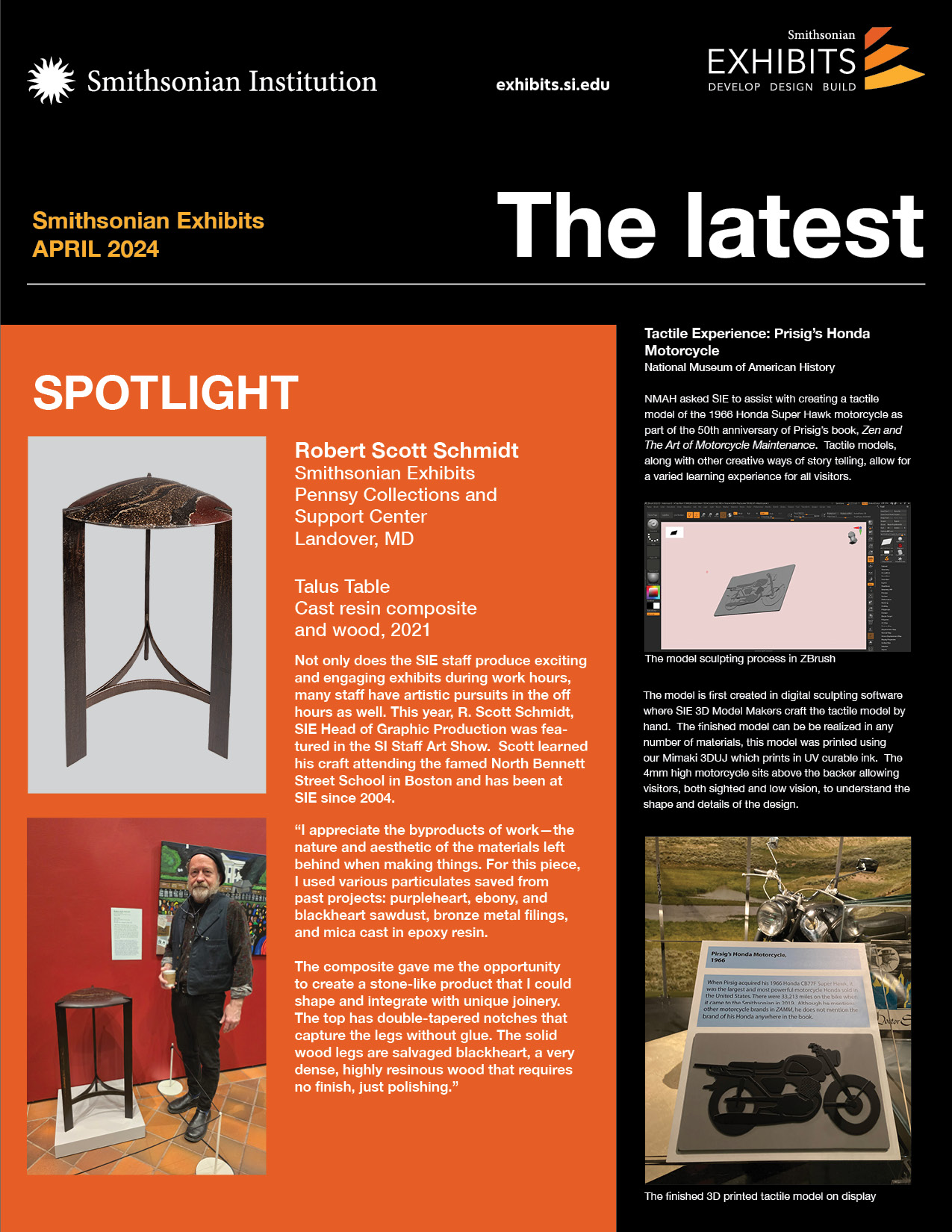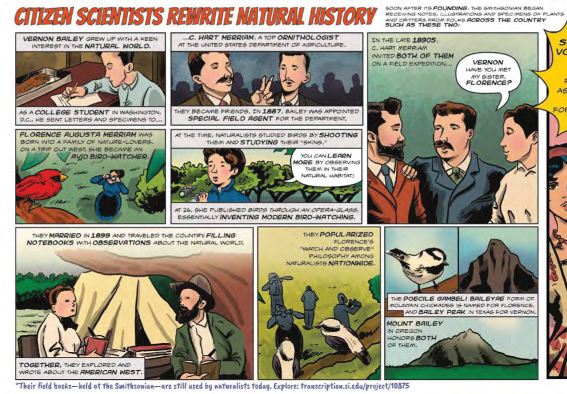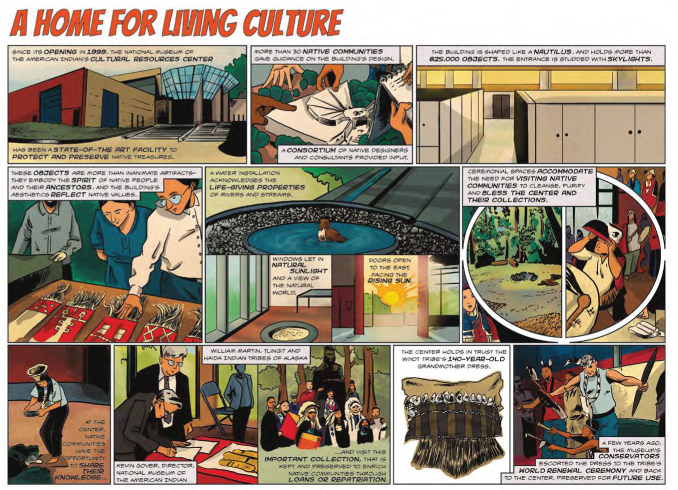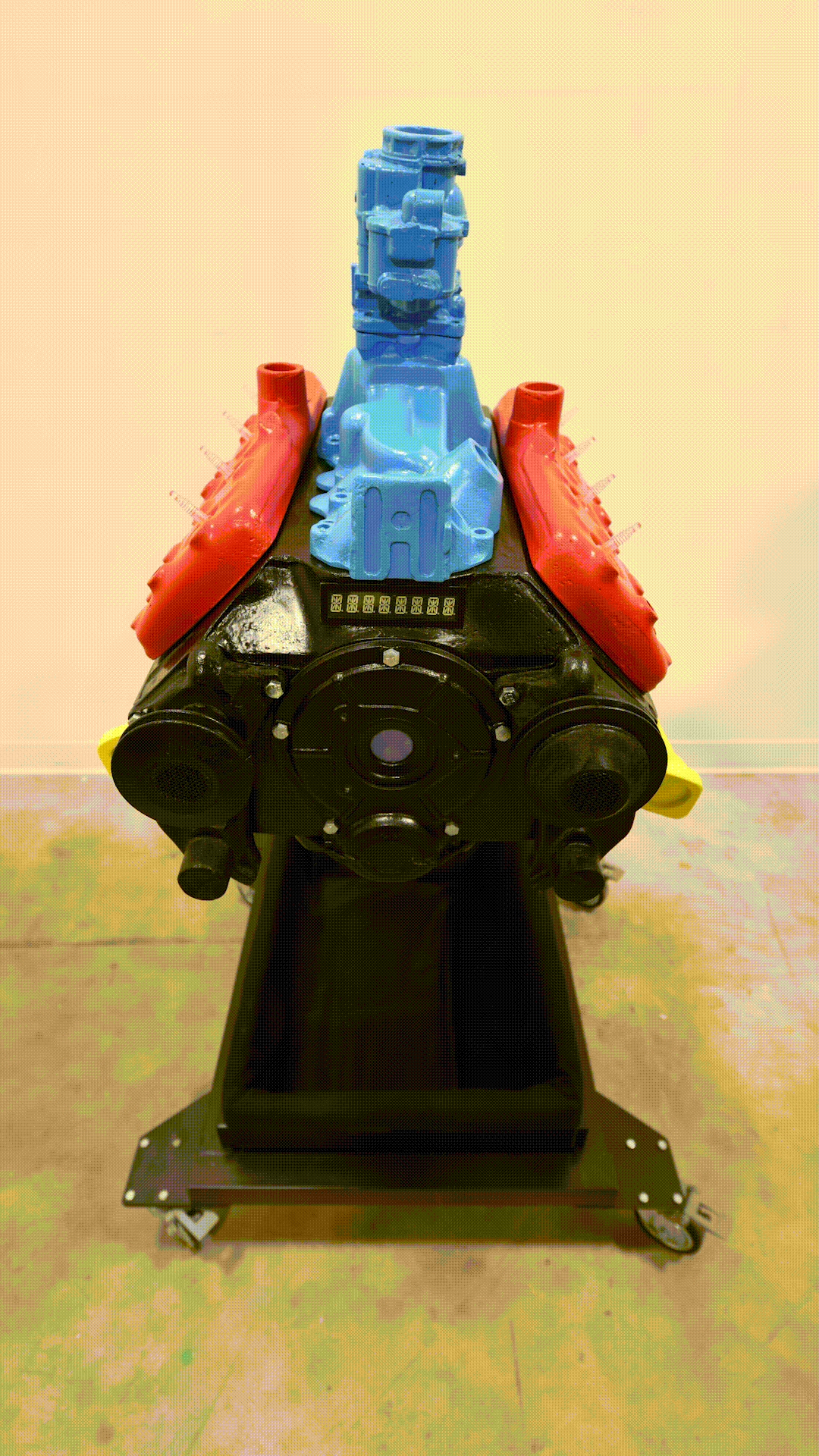Category: Uncategorized
SIE MAY NEWSLETTER: THE LATEST!
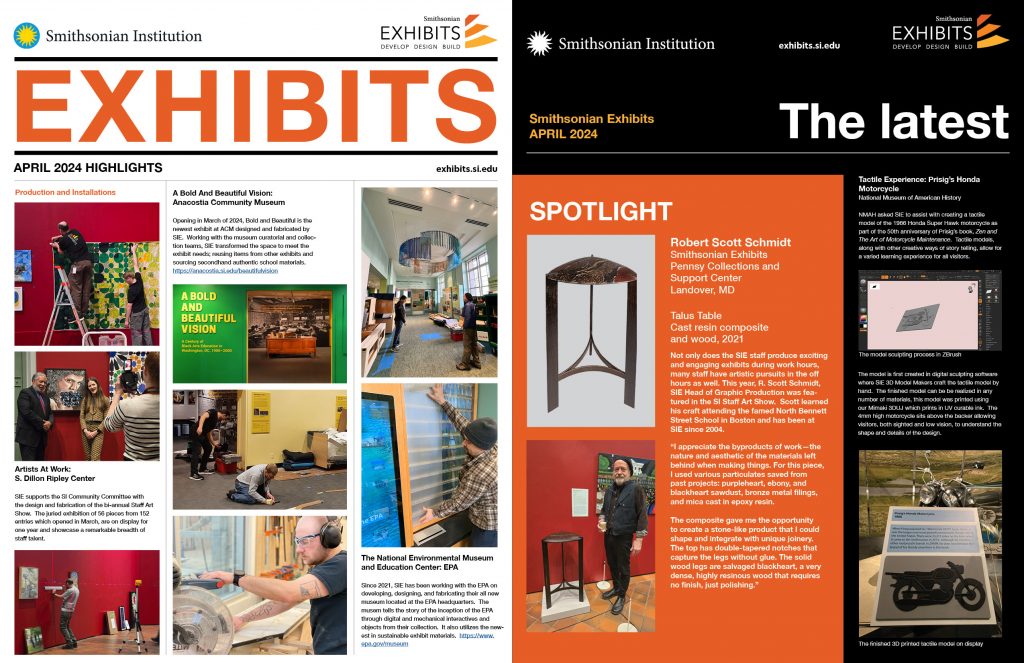
SIE APRIL NEWSLETTER: THE LATEST!
Smithsonian Exhibits 2023 Open House
Thank you to everyone for coming out to the Smithsonian Exhibits Open House 2023! It was a fantastic event with informative sessions and great conversations. A tremendous thank you to the SIE staff for being great ambassadors for the advancement of exhibitry.
A special thank you to our guest collaborators:
Joy Mana, Product Manager, Gaylord Archival
Laura Mina, Conservator of Costumes and Textiles, National Museum of African American History and Culture
Dr. Larry Wilen, Senior Research Scientist & Lecturer, Yale CEID
Links to the presentations can be found here

















This Old House
Nestled in 2,650 acres of protected land on the Chesapeake Bay in Edgewater, Maryland, sits the oldest building in the Smithsonian’s collection that’s still in its original location.
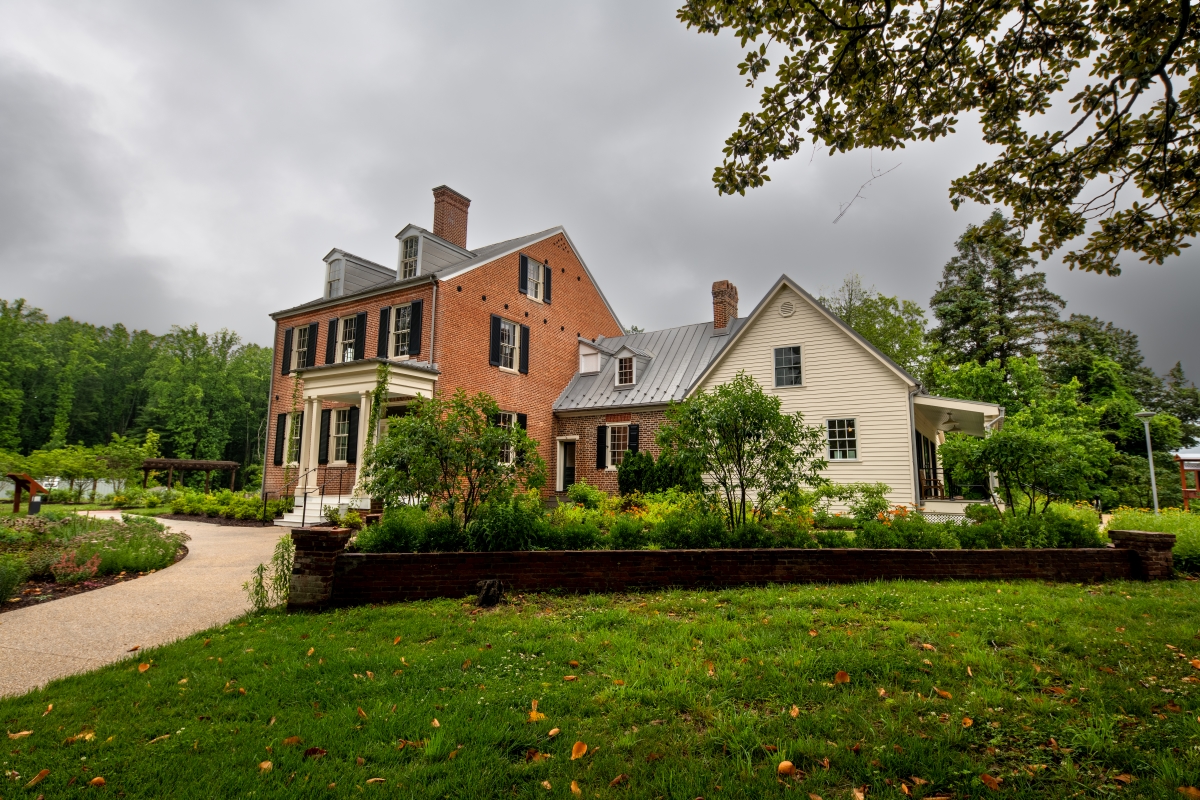
Woodlawn House was built in 1735 for tobacco planter William Sellman and his family. The Smithsonian Environmental Research Center (SERC) purchased the house in 2008 and rehabilitated it in 2020. Over the past few years, Smithsonian Exhibits (SIE) has worked with SERC to transform the house and the surrounding landscape into the Woodlawn History Center exhibition and the Woodlawn History Trail.
The exhibition and the accompanying trail tell the story of the diverse people who lived in and around Woodlawn House and shaped the surrounding landscape. This includes Indigenous people, enslaved people, indentured servants, sharecroppers, tenant farmers, and others.
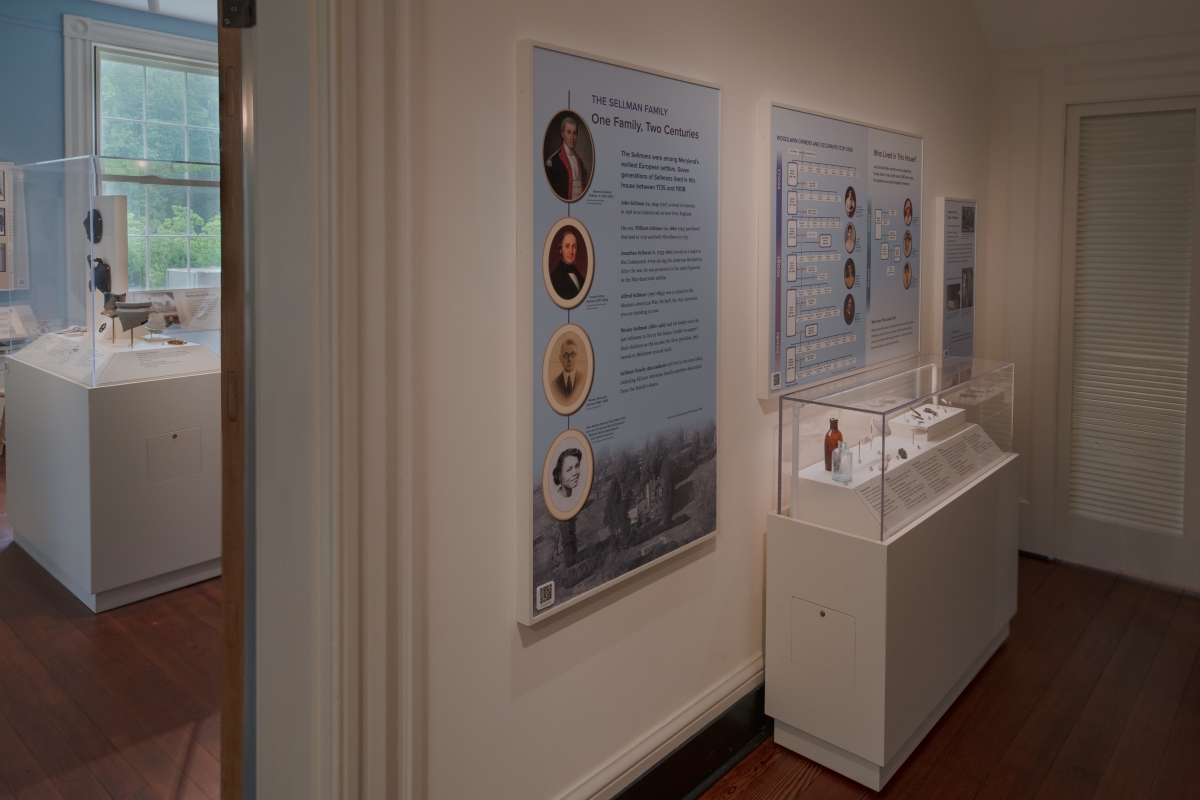
Working in a historic house proved an interesting challenge for SIE’s team. Unlike working in a typical museum gallery, SIE had to be careful to preserve the historic structure and all of its architectural details.

The exhibition features artifacts uncovered by SERC’s team of citizen scientist archaeologists. These include everything from ancient Native American projectile points to glass milk bottles from the nearby dairy farm.
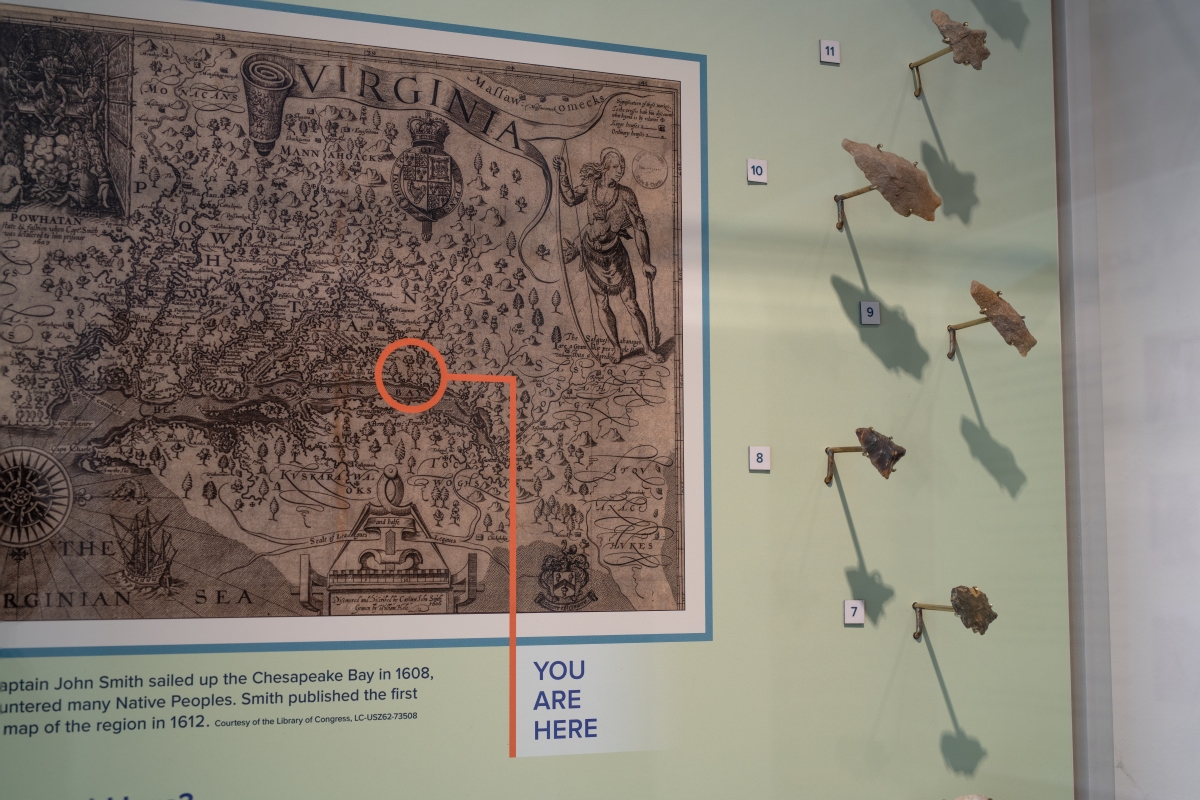
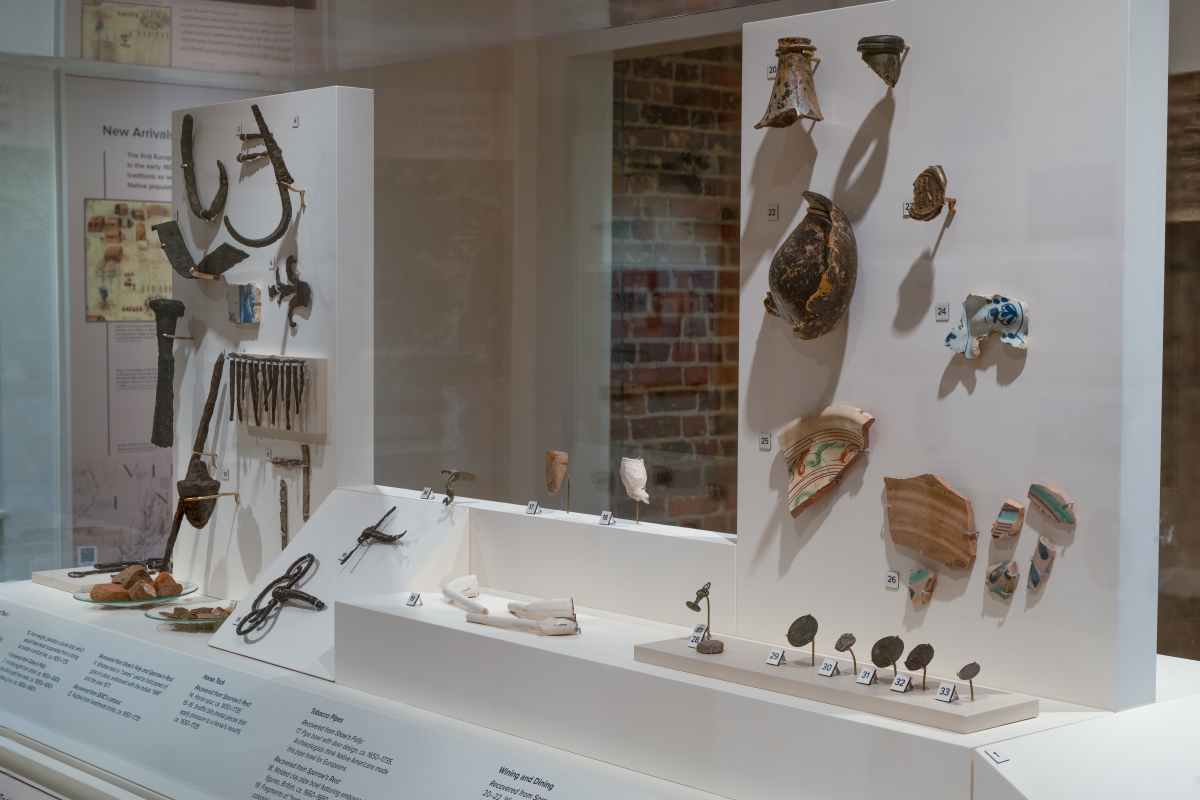
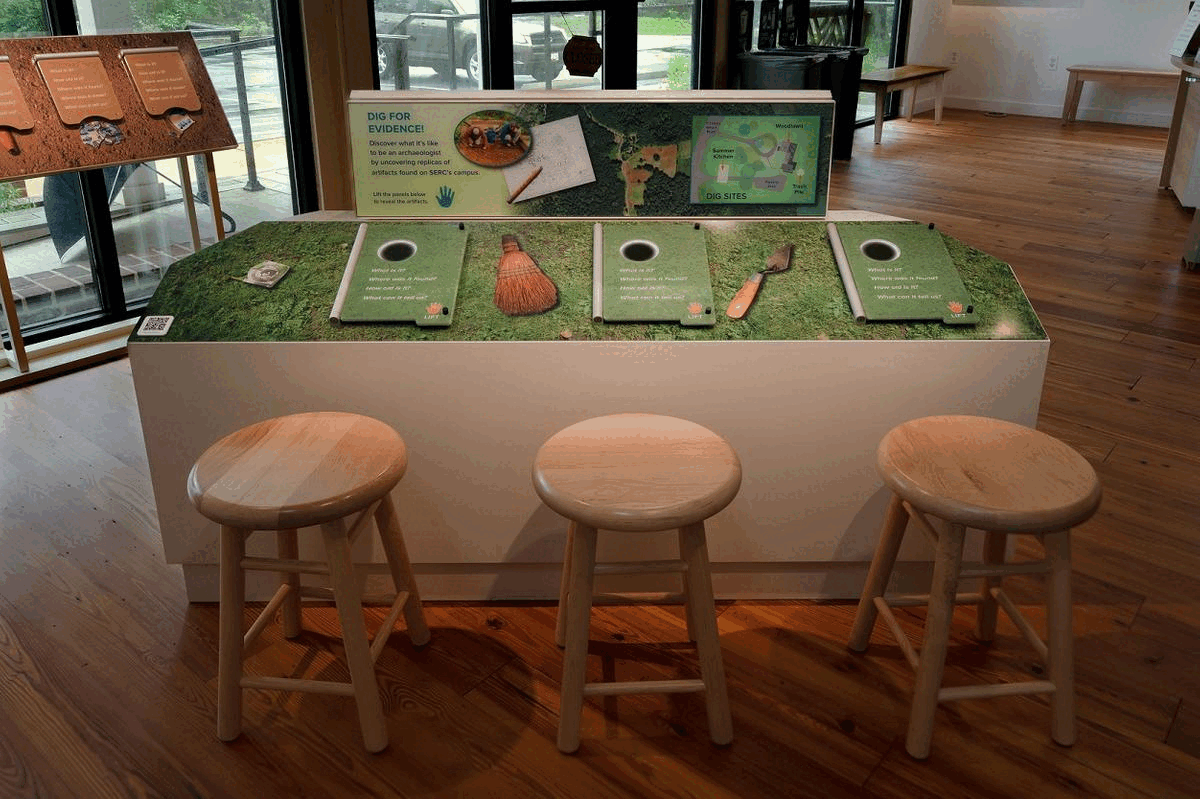

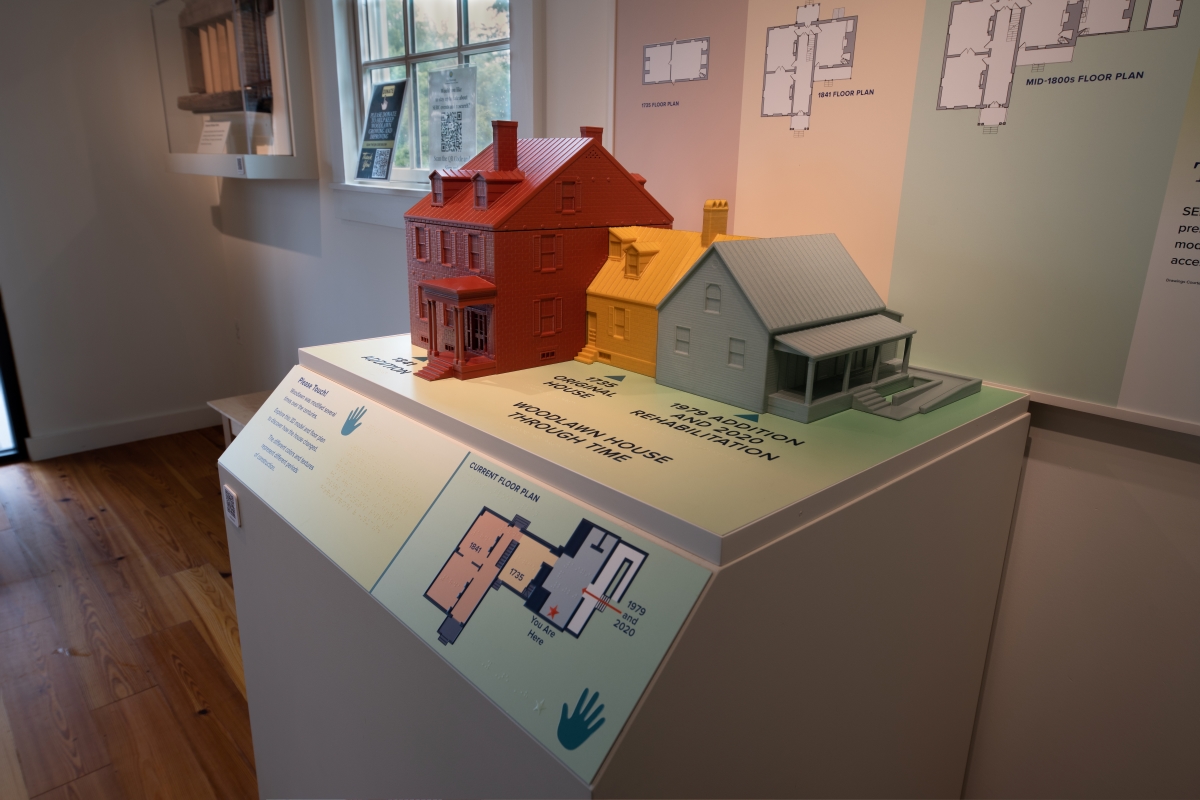
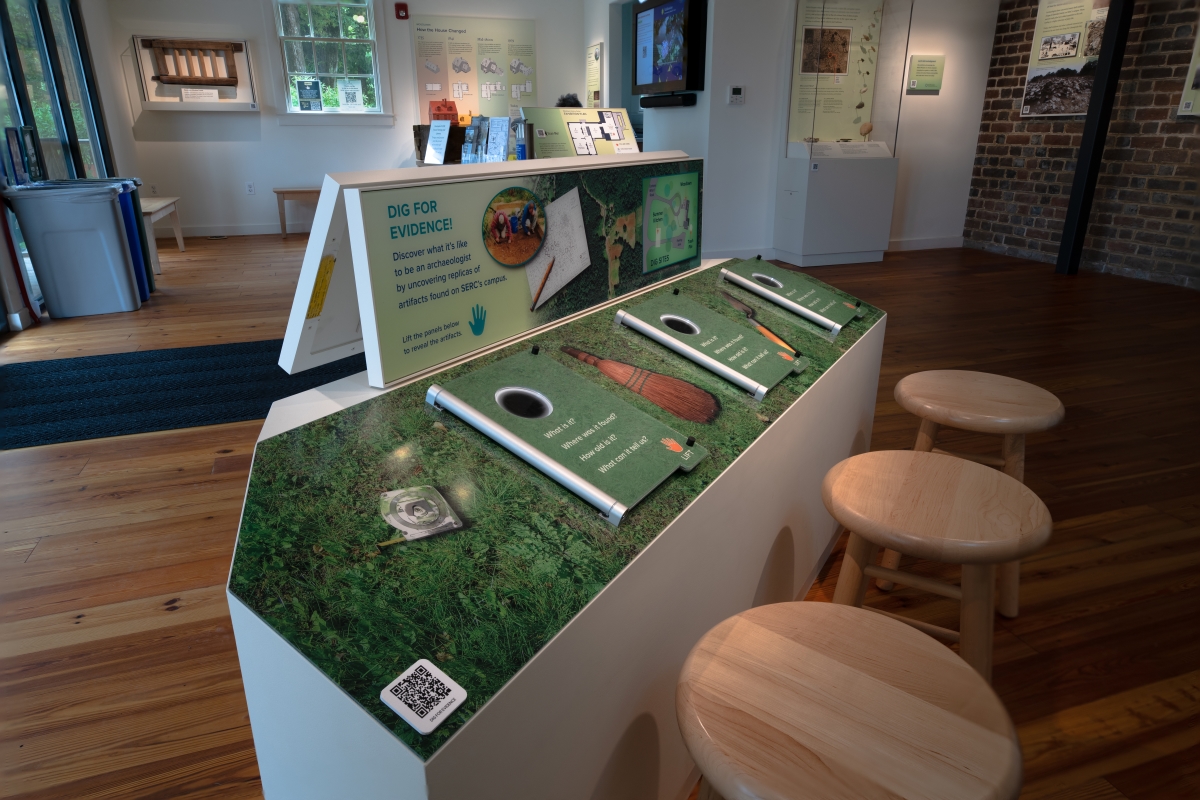
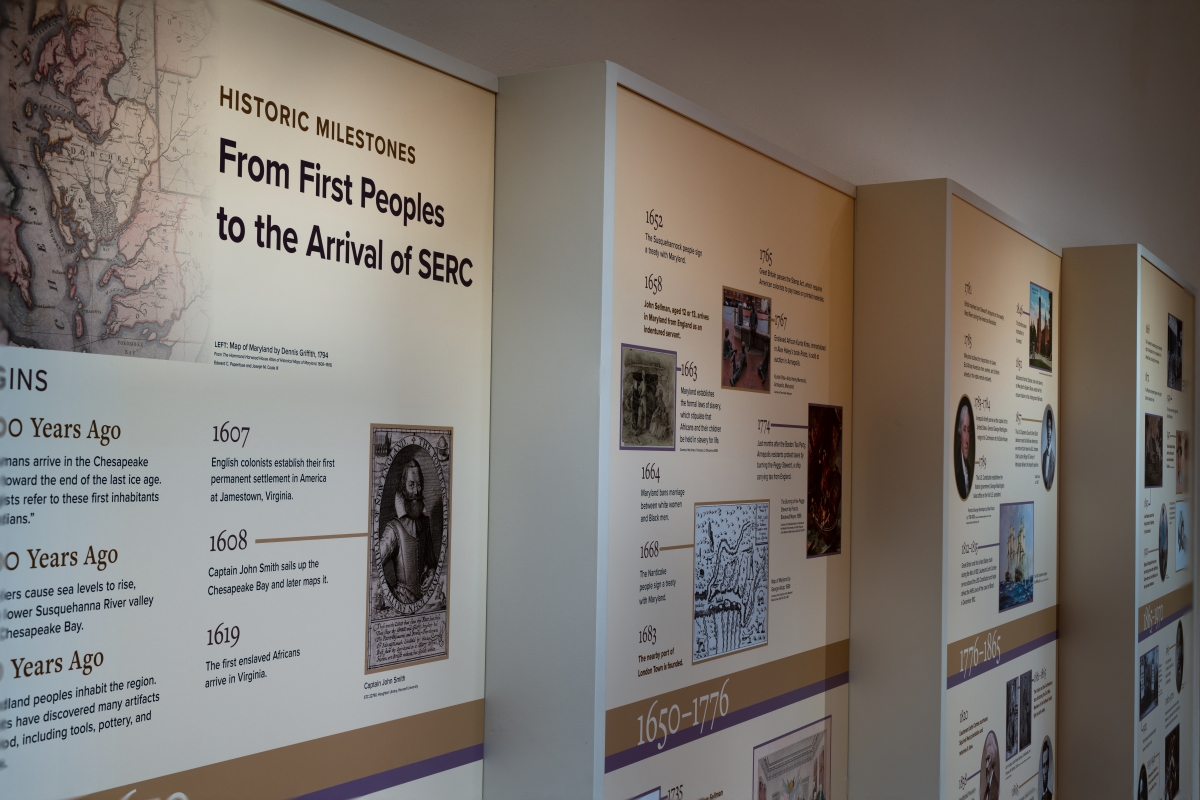
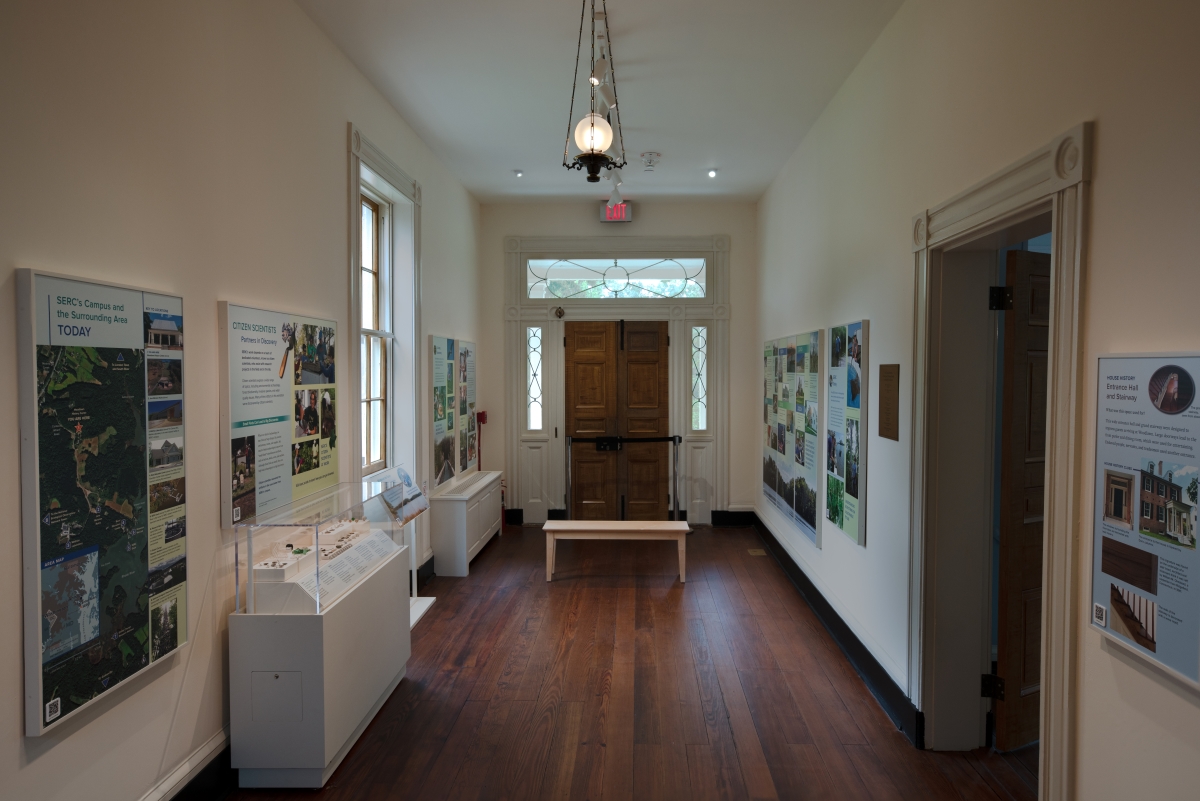
Outside the house, the Woodlawn History Trail takes visitors on a self-guided walking tour past neighboring historic sites.

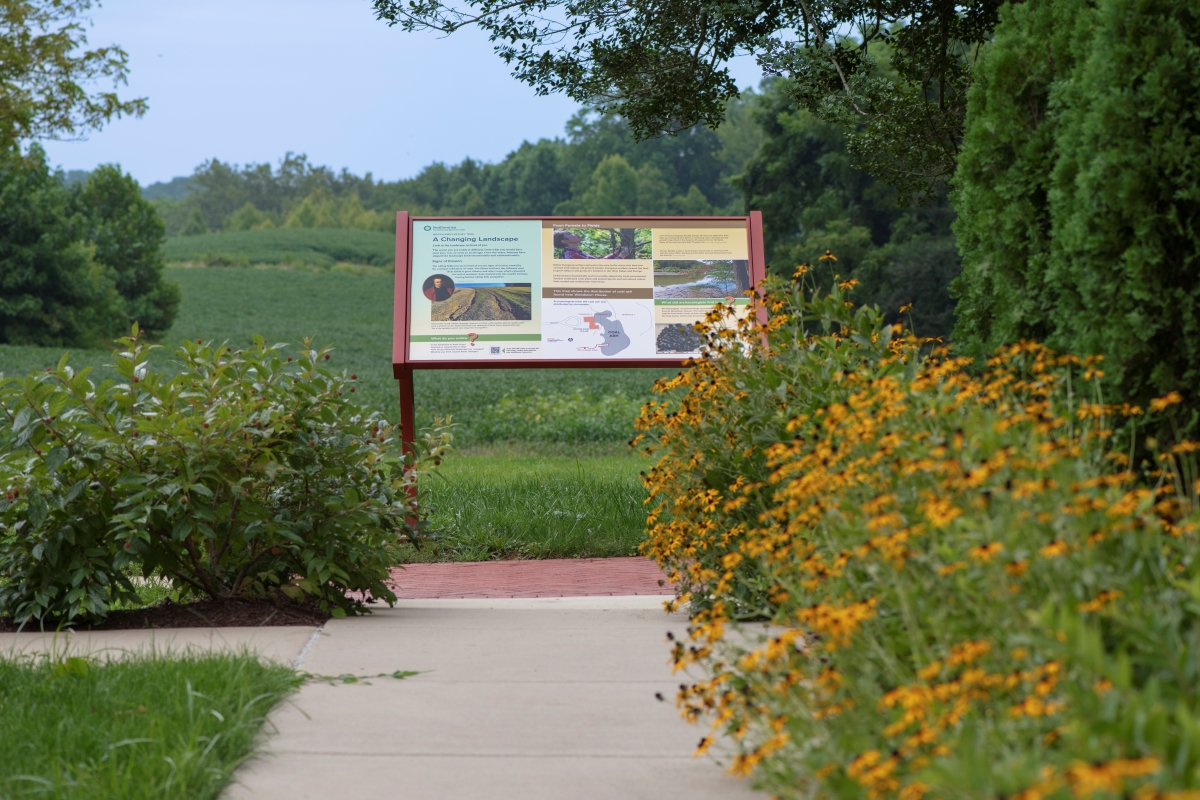
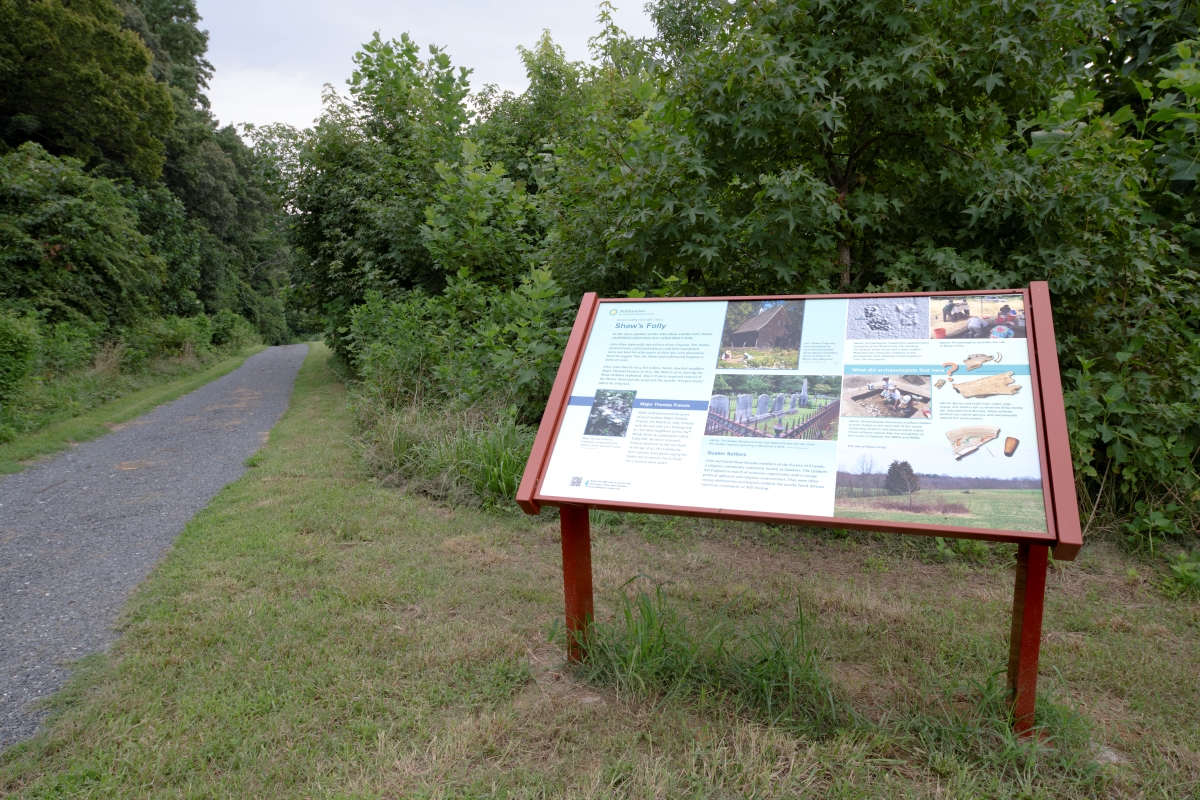
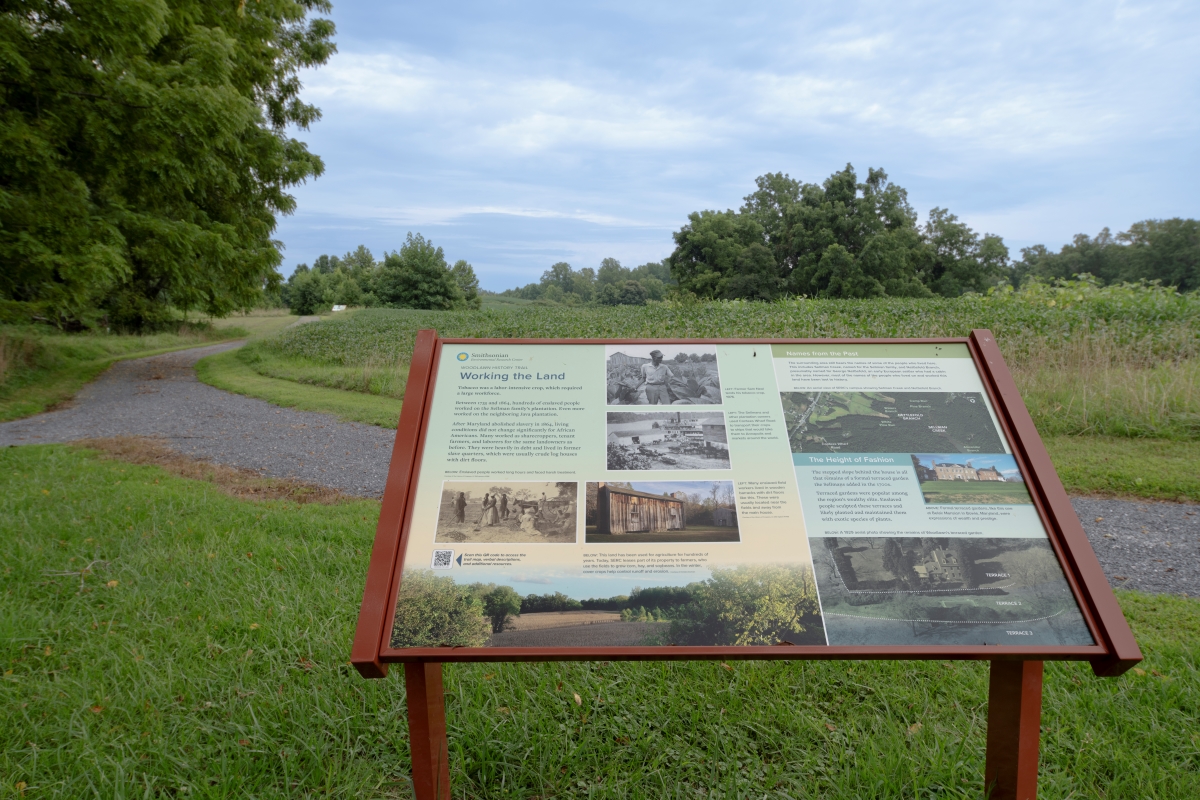
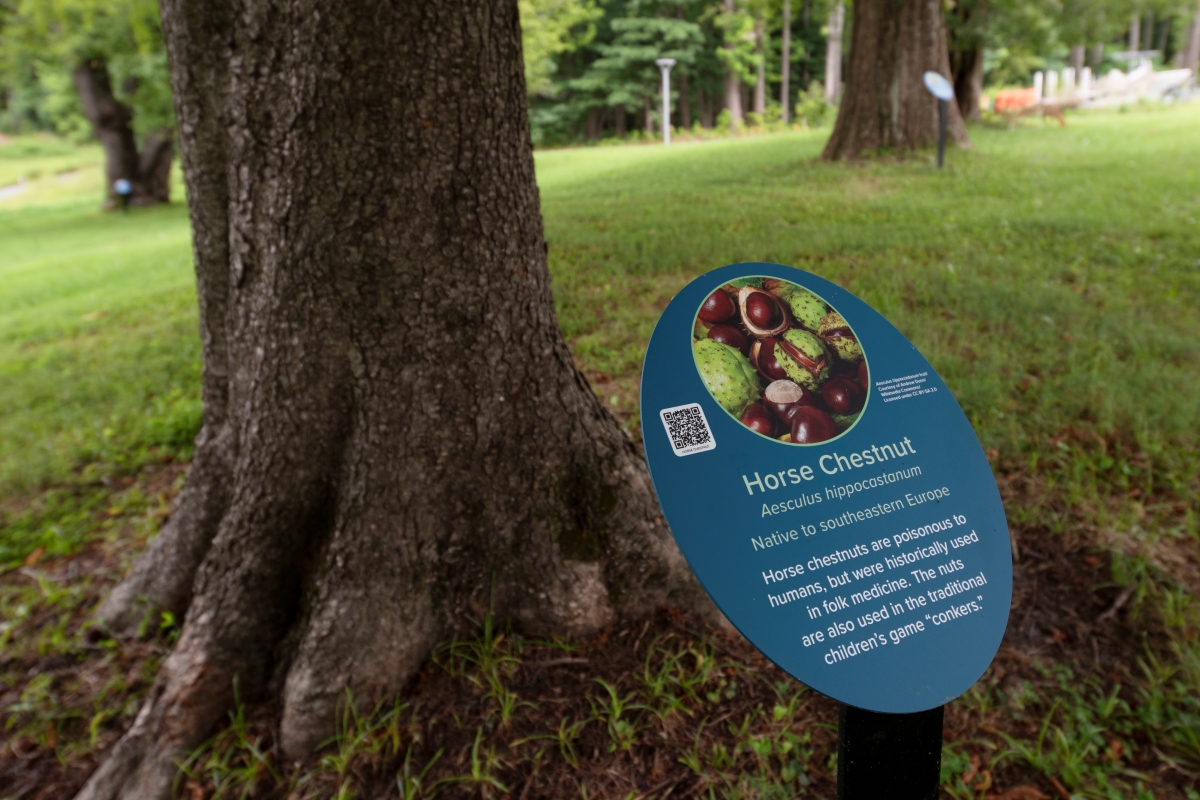
SERC’s campus and the Woodlawn History Center are open to the public on certain days. Visit SERC’s website to plan your visit.
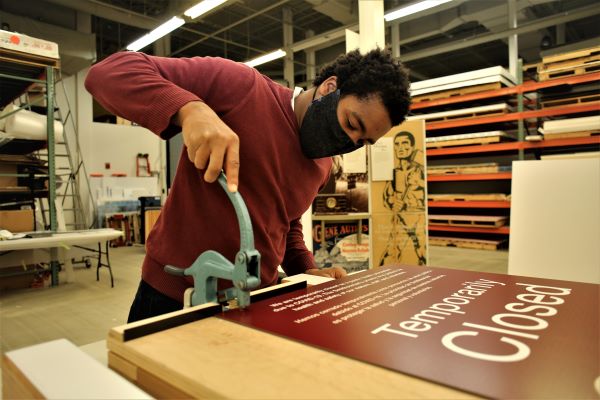
Catching Up with Our Interns
Since we last caught up with SIE interns Bre Patterson and Vic Garrett, they’ve been busy! They have worked their way through SIE’s 3D studio, fabrication, and graphics departments; helped produce and install exhibitions; and even met Smithsonian Secretary Lonnie Bunch! We checked in with them to see what they’ve been up to.
Bre spent the first three months of her internship in SIE’s 3D studio and fabrication department, where she learned about 3D printing—a completely new skill for her.

One of Bre’s first projects was testing the durability of 3D prints to see how they hold up to frequent cleaning with disinfectant solutions. This is critical to determining how Smithsonian museums can provide safe and hygienic access to tactile exhibition components.
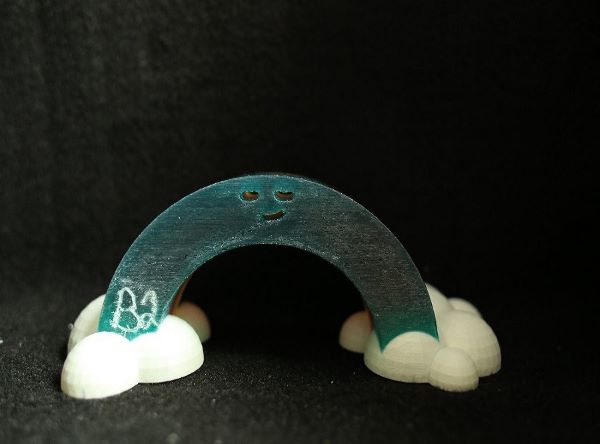
Bre showed her creativity by making a video demonstrating her process. Beat courtesy of iCAN intern Thomas Tate/THEARC Theater
Bre also helped fabricate exhibition components for Baseball: America’s Home Run, an upcoming exhibition at the National Postal Museum. She learned how to pack and crate exhibition components for transport, and assisted with installation. “I liked how everyone takes part in showing me their roles and their steps through them,” she said. “Every week I gained new knowledge.”
Since January, Bre has been working in SIE’s graphics department, where she has been learning to use SIE’s large format printers and Adobe software. During her time in graphics, she has helped frame and install photos and produce graphics for the Smithsonian’s staff photo show, Capturing the Moment.
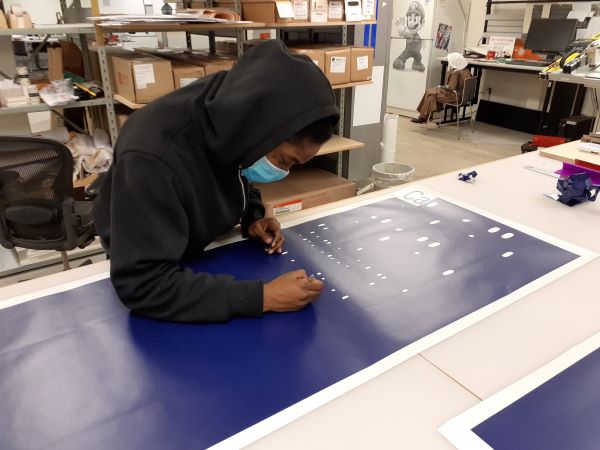
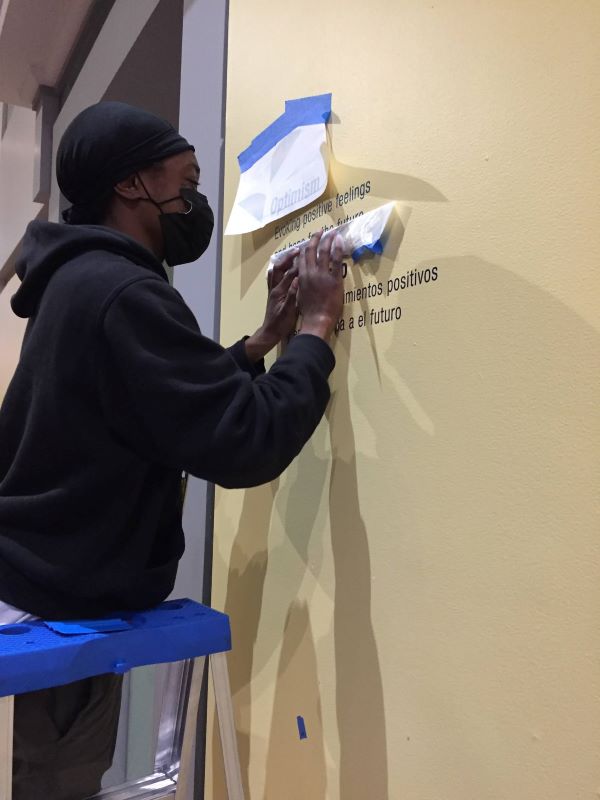
Vic spent his first three months in SIE’s graphics department, where he learned new skills while helping produce COVID-19 safety graphics for Smithsonian museums.

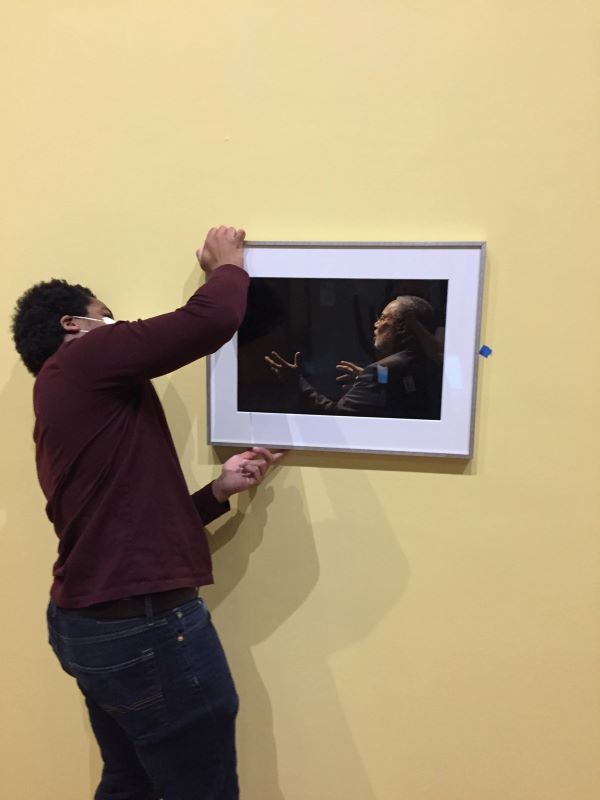
Since January, Vic has been working in SIE’s 3D studio and fabrication department, where he has been helping assemble and install exhibition components. Vic enjoys visiting museums for installations. “It makes you feel really special to be there without anyone else around and before the lights are on,” he said.
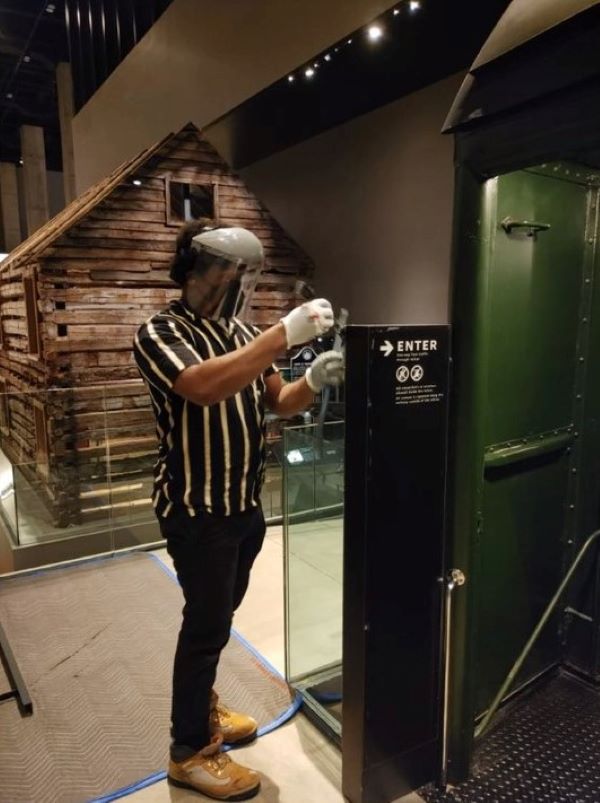
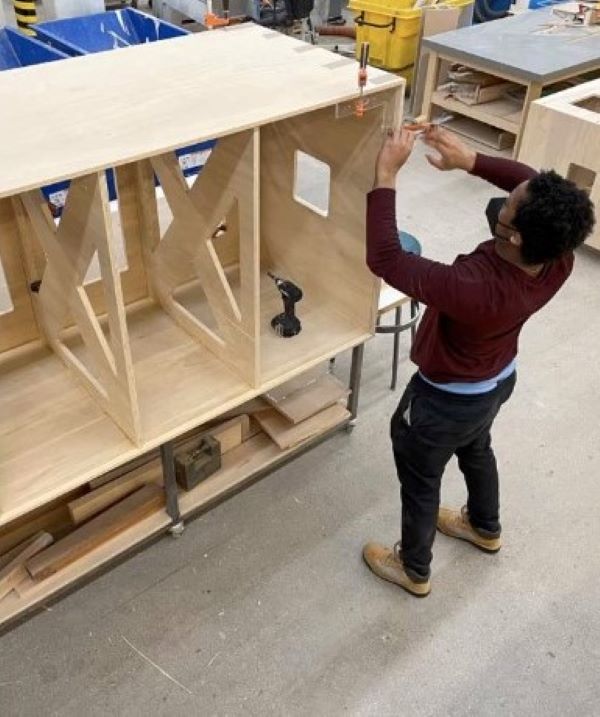
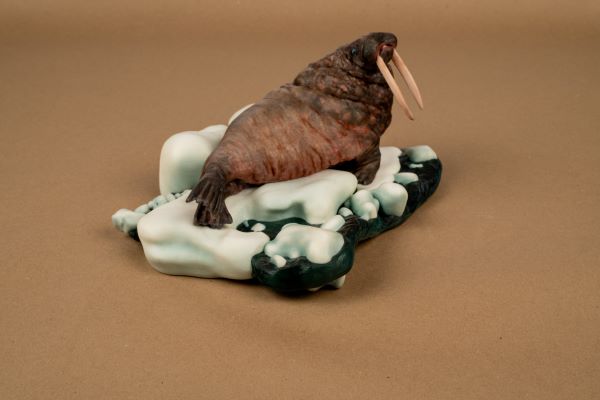
Vic also honed his video editing skills by creating and starring in a series of “how to” videos demonstrating how to assemble Frank display cases.
One of the highlights of the internship so far for Bre and Vic was meeting Smithsonian Secretary Lonnie Bunch virtually. They spoke with him about their work at SIE and what they hope to do in their careers. Secretary Bunch sent them signed copies of his book A Fool’s Errand, and they made plans to speak with him again before the end of their internship.
We will also be checking in with Bre and Vic before the end of their internship to hear more about their great work, so stay tuned!
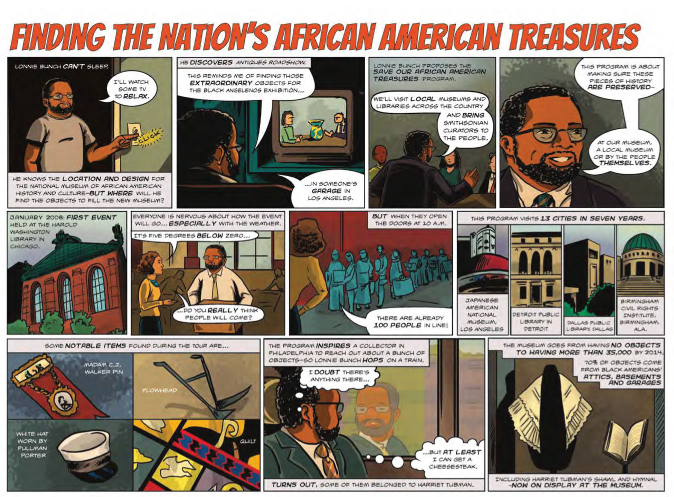
Birthday Comic
Happy Birthday to Us!
Okay, so a little early—our actual birthday is August 10—but it’s been a weird year and if we want our cake and comics a little early, so be it.
This year, the Smithsonian turns the big 1-7-5! Which according to my notes … is well past human lifespans so I get to make up the traditional gift. I’m going with cake and comics, which works for two reasons:
- Cake is a timeless birthday tradition in the U.S. (Also, I really want to work on an exhibit about cake, so if anyone out there is in the position to make that happen, please email me. Thanks!)
- SIE’s very own Evan Keeling was asked to create a birthday comic for the Smithsonian. It appeared in Impact magazine but you can see it here. (Also, please note that the version in the link is accessible to those using screen readers.)
Impact is written by a team at the Smithsonian’s Office of Advancement. The magazine is for a range of donors and volunteers across Smithsonian’s museums, research centers and the National Zoo. It gives readers a sneak peek into stories they might not have otherwise known. An audience that is just learning about us for the first time would likely have the usual questions:
- Who was James Smithson?
- What was your first building?
- What were the names of the owls that lived in the Castle?
Okay, I don’t think anyone is asking that last one all that often, but it’s a great bit of trivia you can use to impress your friends.
An audience that’s already visiting and supporting the Smithsonian regularly probably had a chance to get those answers before. The Impact group wanted something that would, well, have a little more impact for their readers.
Highlighting Moments Instead of Dates
Elise Walter, one of the writers in Advancement, saw Evan give a presentation about how to effectively use comics as a storytelling device at our Open House in 2019. She already knew that Advancement wanted something a little different for the 175th anniversary. Using a comic would let them highlight individual moments of Smithsonian history and let each story take on its own point of view.
Elise enlisted Pam Henson at the Smithsonian Archives to help select stories that could be developed into comic panels. As they chased down the best stories for the comic, they knew they wanted to find some of the more obscure bits of Smithsonian history.
Visual Storytelling
The selected stories were interesting—real hidden gems of the Smithsonian. But were they visually compelling? They consulted with Evan throughout the process, who helped them determine what stories would work in a visual way, and what characters could pull a reader in. Different stories required different points of view. Some comics needed multiple panels; some stories benefitted from one larger panel to represent the outcome. Comics can be used to achieve numerous types of storytelling in the same publication, as the examples below show.
Playing with Perspective
The comic about Florence August Merriam and Vernon Bailey shows how the 19th century science power couple completely changed the study of birds. The literal bird-eye views show the birds up close and the observers far below them. This emphasizes their approach to studying birds—one that radically changed the field and invented modern birdwatching.
Highlighting the Result
T he story of how the First Ladies’ gowns were collected for the National Museum of American history is an interesting story—but the strongest way to show it visually is by their success. Showing a bunch of people in conversation over and over isn’t nearly as fun as looking at three of the gowns.
he story of how the First Ladies’ gowns were collected for the National Museum of American history is an interesting story—but the strongest way to show it visually is by their success. Showing a bunch of people in conversation over and over isn’t nearly as fun as looking at three of the gowns.
Introducing Complicated Topics
Comics can take a complex topic and make it easier to understand. Illustrating the story of the NMAI Cultural Resources Center makes the it easier for readers to learn how this unique facility works.
First-Person Storytelling
The speech and thought bubbles used in comics let a specific narrator explain (or think through) tough problems. The reader gets to see how a main character approaches a situation.
Be sure to check out the entire comic (here’s that link again) to see more moments of innovation!

A Souped-Up Prototype
What has eight cylinders, flashing lights, and vibrates when you touch it? The tactile engine prototype Smithsonian Exhibits recently designed and built for the National Air and Space Museum.
This is a prototype of a hands-on interactive planned for NASM’s Nation of Speed exhibition, opening soon. NASM staff and volunteers will use the interactive in facilitated experiences to help visitors understand how engines generate speed and how they can be modified to go faster.

The interactive is based on the iconic Ford Flathead V-8 engine, produced between 1932 and 1953, which powered hot rods and other modified cars.
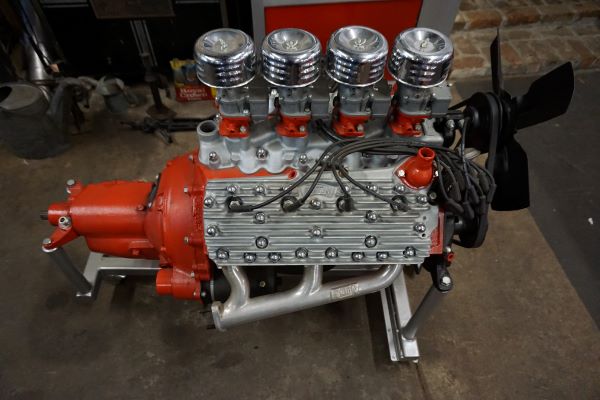
This project was funded by the Smithsonian Accessibility Innovations Fund (SAIF). Our goal was to ensure that the resulting interactive is accessible to all visitors, including visitors who are blind or have low vision and visitors who are deaf or hard of hearing.
SIE, NASM, and Access Smithsonian met in November 2019 to kick off the project. To get us started, SIE exhibit specialist Enrique Dominguez tracked down a foam model of a Ford Flathead V-8 engine. (Who knew these things existed?)
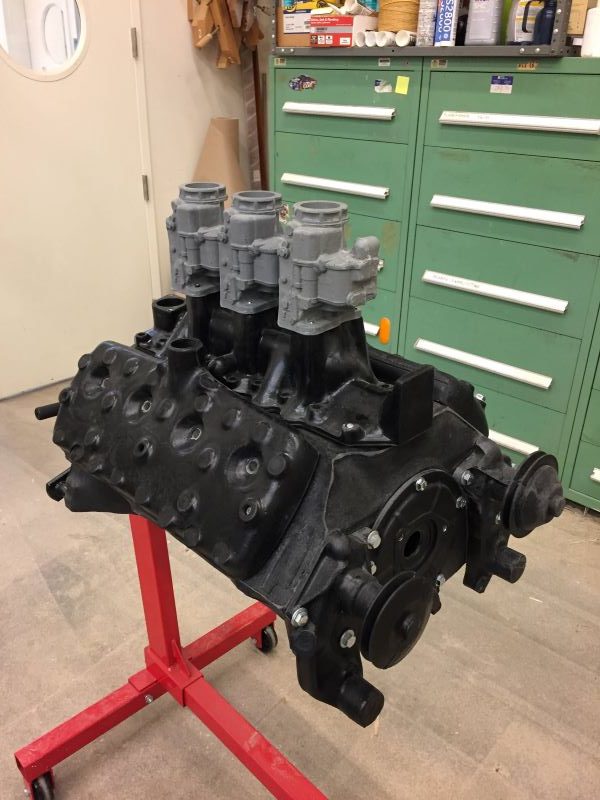
The foam model provided an excellent starting point. But the team wanted to add more parts for visitors to handle, including cylinder heads, spark plugs, intake manifolds, carburetors, and exhaust manifolds. To help visitors understand what the different engine parts do, we decided to color code them according to their functions: blue for intake, red for combustion, and yellow for exhaust.
We also wanted to demonstrate how to modify an engine to make it faster. To achieve this, we decided to include interchangeable stock and performance parts. To help distinguish the parts from each other, we decided to color the stock parts a lighter shade and the performance parts a darker shade.
Once we had a plan in place, SIE designer Elena Saxton worked with SIE exhibit specialists Enrique Dominguez and Jeff Rosshirt to design the prototype.

We had originally intended the interactive as a purely tactile experience. But after some discussion, the team decided to incorporate additional multisensory features to make the experience accessible to a wider audience. These included audio clips of stock and performance engines running, touch-activated vibrations to simulate the feel of a running engine, flashing LEDs to demonstrate the firing order of the cylinders, and a digital display showing the engine’s RPMs (revolutions per minute). SIE exhibit specialist Jeff Rosshirt took the lead in developing these components using Arduino, an open-source electronic prototyping platform.
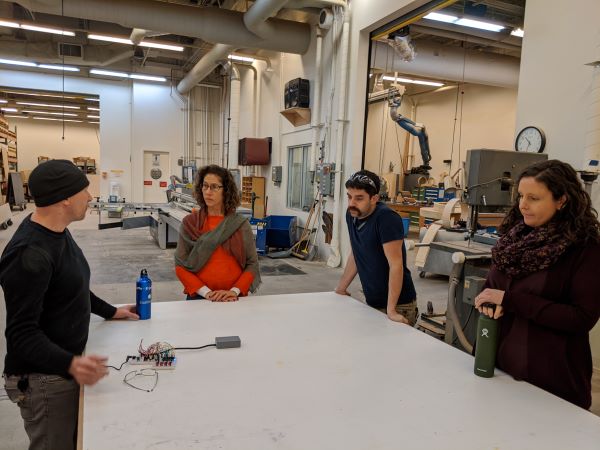
While Jeff was programming the Arduino, SIE model and mount maker Danny Fielding got to work making replicas of the engine parts. These needed to be light enough to attach to the engine block with magnets but durable enough to withstand frequent handling.
Danny used actual engine parts to make the molds. He encased the original parts in liquid rubber (silicone) and left them overnight to cure.
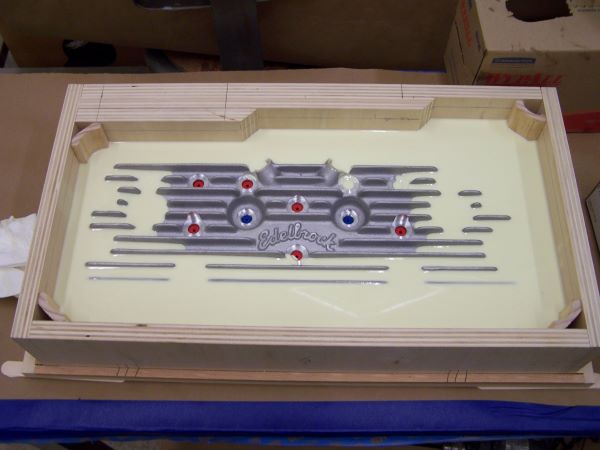
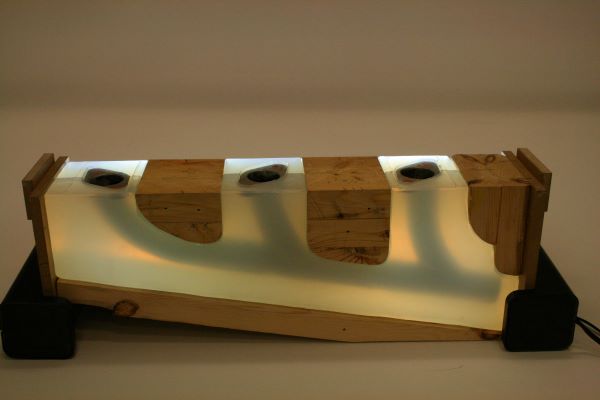
After removing the original parts from the molds, Danny cleaned and prepared the molds for casting. He tinted the liquid resin the desired colors and poured it into the molds, which he quickly capped off to stop the foam from expanding. Once cured, the foam engine parts were removed from the molds and filed and sanded to remove any surface imperfections.


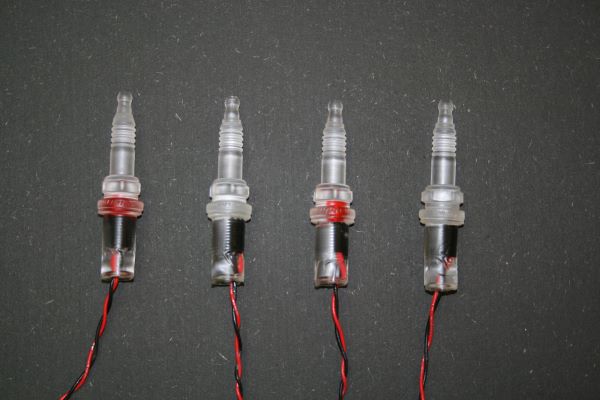
SIE exhibit specialist Enrique Dominguez added fiberglass to many of the parts for durability and installed magnets and pin locators to make them quick and easy to install and deinstall.
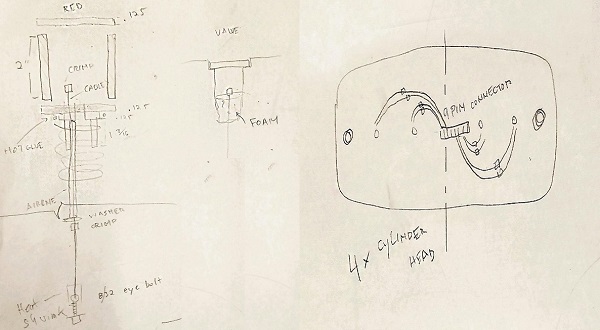
Once the parts were ready, SIE exhibit specialist Jeff Rosshirt installed the Arduino microcontroller.
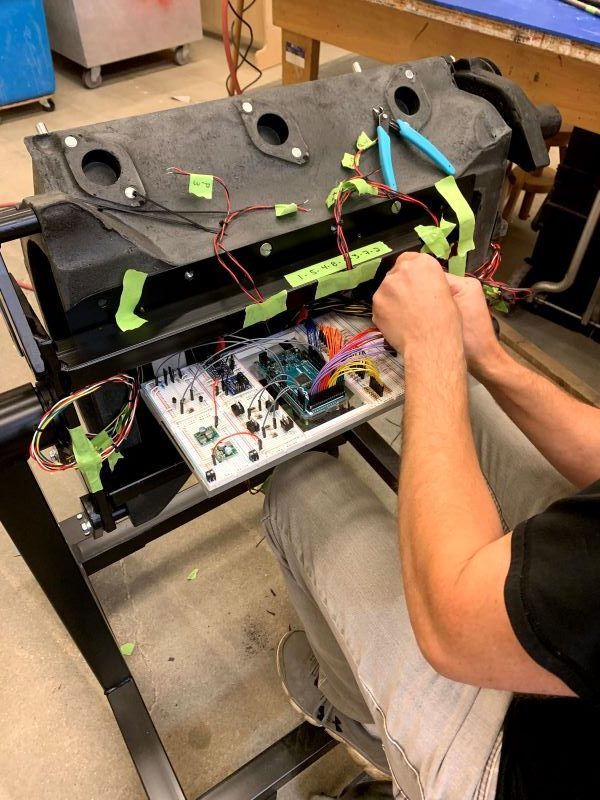


Once the Arduino components were programmed and installed, Enrique and Jeff assembled and mounted the engine block on a custom welded stand with locking wheels. The stand can be tilted up to 45 degrees in either direction to facilitate access to visitors in wheelchairs and small children. They also installed a tray underneath to store the engine parts when not in use.
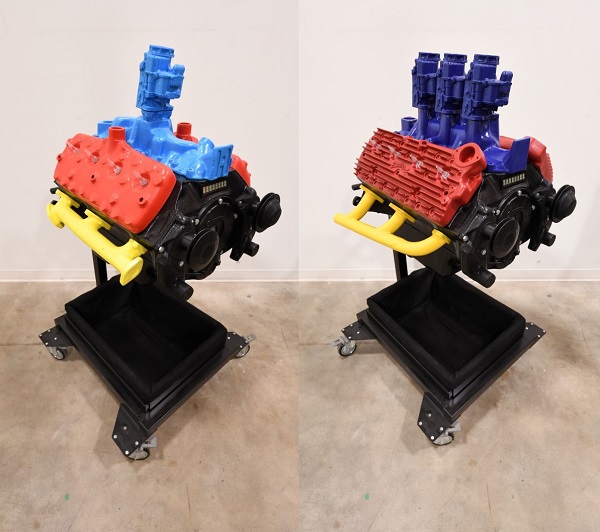
The finished prototype can be operated in three modes: manual mode, which allows visitors to see the firing order of the cylinders in slow motion; stock mode, which demonstrates how the engine would run with stock parts; and performance mode, which demonstrates how the engine would run with performance parts. NASM’s facilitators can even simulate an engine breakdown and control the engine’s RPMs using an optional foot pedal. In fact, just about the only thing this prototype doesn’t do is drive!
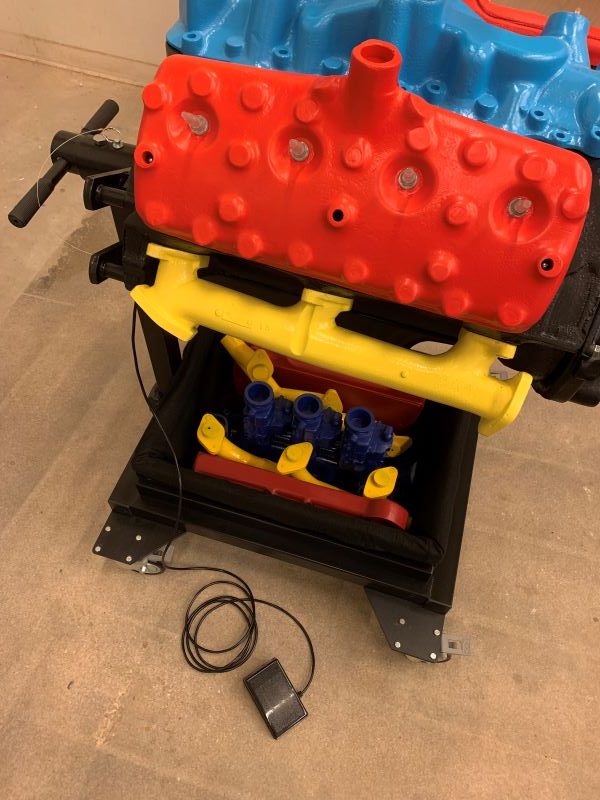
Watch a video of the finished prototype in action below.
Unfortunately, the COVID-19 pandemic prevented us from testing the prototype with visitors as we had originally planned. But stay tuned—NASM hopes to roll out the prototype at the Udvar-Hazy Center once it is safe to do so.
This project allowed SIE to explore the possibilities of incorporating multisensory components into hands-on interactives to make them accessible to a wider audience. We learned a lot and look forward to future opportunities to continue this important work!
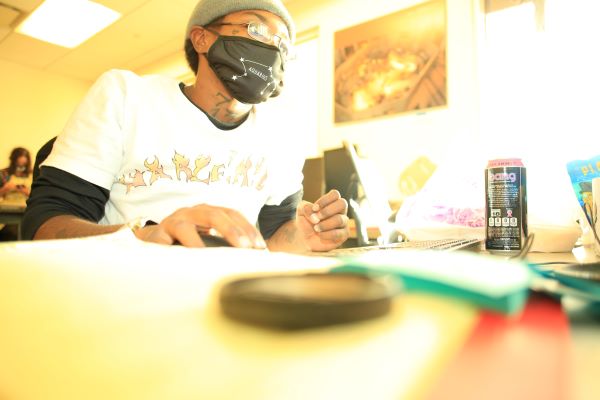
Meet Our New Interns!
Smithsonian Exhibits is thrilled to welcome two new additions to our team: Bre’Launna Patterson and Victor Garrett who joined us in October for a year-long internship funded by the Smithsonian Institution.
Bre and Vic will be working in SIE’s fabrication, graphics, and 3D studio departments. They will spend two months in each department, learning the ropes. After six months, they will each select one department to spend the rest of their internship in, and will complete a solo project.
Before joining SIE, Bre was a contractor for THEARC Theater, a performing arts venue in Washington, DC, where she worked as a stagehand and master carpenter among other duties. Her goal is to gain skills that she can use to push others and herself as a female entrepreneur in tech, dance, MCing, and other fields. “When I first heard about the Smithsonian Exhibits production shop, I knew it was what I have been preparing for,” said Bre. “I am excited to learn more, especially in the fabrication and 3D print shop.”
Bre is spending her first two months in SIE’s fabrication department and 3D studio. Her first project has been testing the durability of 3D prints made with SIE’s new Mimaki printer to see how they hold up to frequent cleaning with disinfectant solutions. This is critical to determining how Smithsonian museums can provide safe access to tactile exhibition components during and after the COVID-19 pandemic.

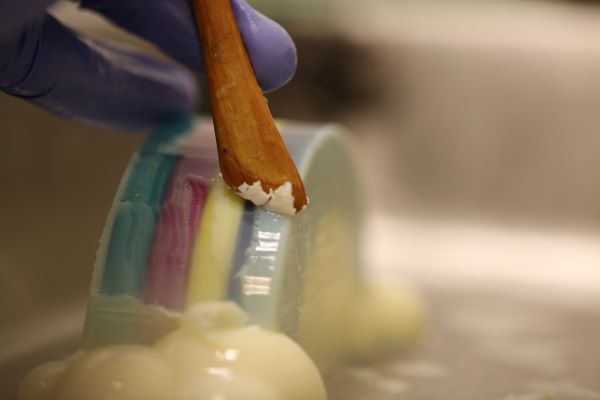
Vic heard about the internship at Joe’s Movement Emporium in Mount Rainier, Maryland, where he was working as a theater tech. “It wasn’t until I found theatrical production that I discovered my talent for building, fabrication, and all things ‘hands-on,’” he said.
Vic has fond memories of visiting the Smithsonian National Air and Space Museum as a kid. “Never in a million years would I have expected to have the opportunity to work and learn from the same institution that captivated me years ago,” said Vic. “I hope to gain advanced, unique, and marketable skills that allow me to pursue my goal of using my building skills to serve my community.”
Vic is spending his first two months in SIE’s graphics department, where he is helping produce COVID-19 safety graphics for Smithsonian museums that are reopening. This is important work that helps keep visitors safe. Vic has already learned several new skills, including laminating, cutting and weeding vinyl, and profiling materials (scanning materials to ensure that the colors are calibrated correctly for printing.)
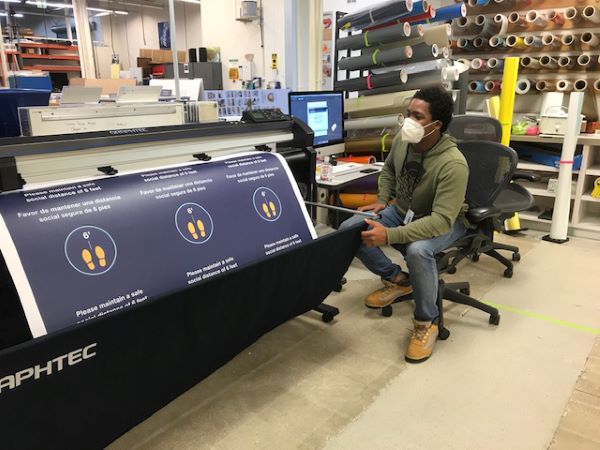

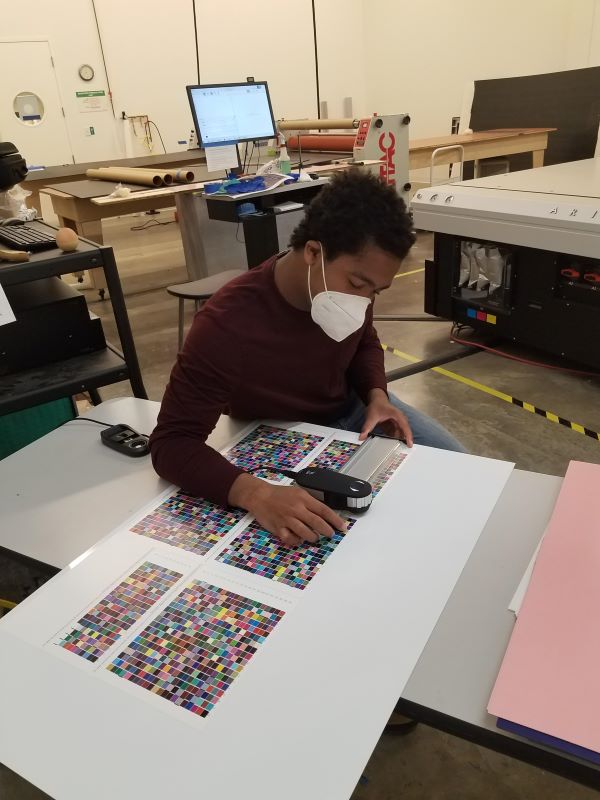
We will be checking in with Bre and Vic throughout their internships. Please join us in welcoming them to the Smithsonian. We’re glad they’re here!
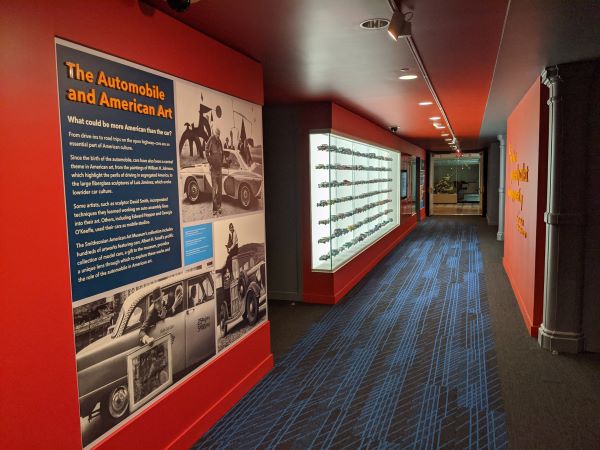
Small Cars, Big Ideas
After being closed for six months due to the COVID-19 pandemic, the Smithsonian American Art Museum (SAAM) reopened to visitors on September 18 with a brand new installation: The Automobile and American Art.
The installation features more than 130 model cars donated by collector Albert H. Small. The cars may be small, but the ideas the installation explores are big: the automobile’s central role in American art and culture. SAAM uses this study collection of model cars as a lens through which to explore car-related artworks in its collection.
Smithsonian Exhibits (SIE) worked with SAAM to develop, design, fabricate, and install The Automobile and American Art, which is located on the museum’s third floor, next to its Luce Foundation Center for American Art.
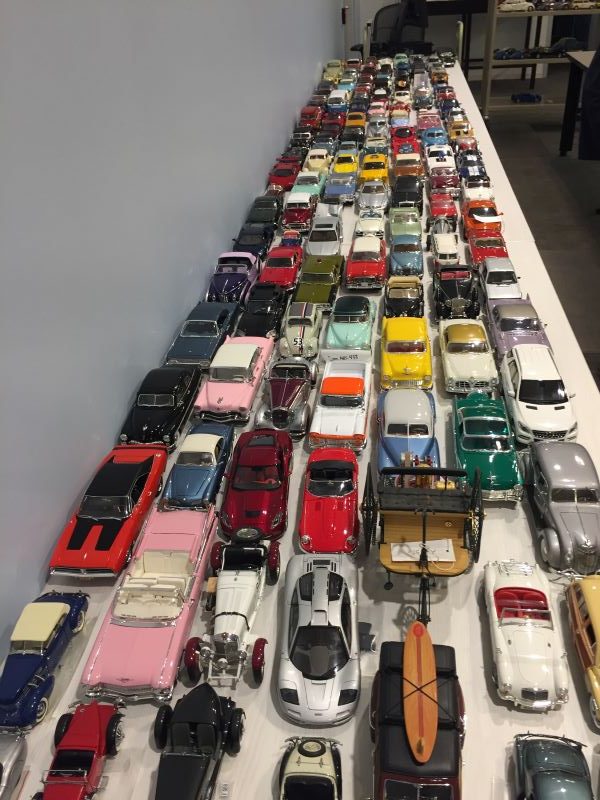

The goal of the project was to transform a transitional “back of house” space into an engaging installation that would connect the Luce Center with SAAM’s special exhibition galleries.
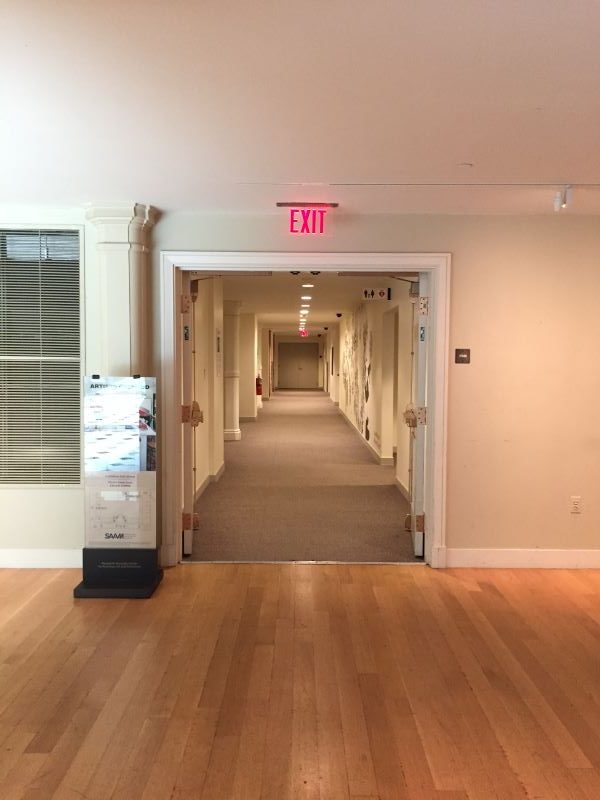
SIE designers Elena Saxton and Madeline Wan took inspiration from car culture in their designs, using bright colors and carpet tiles evoking tire treads.

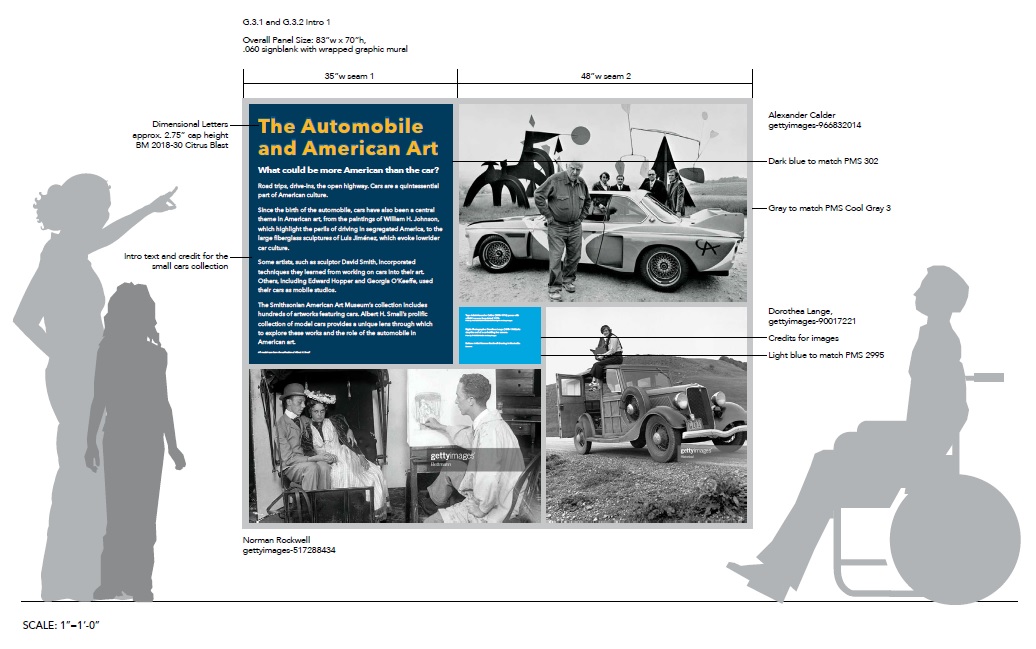
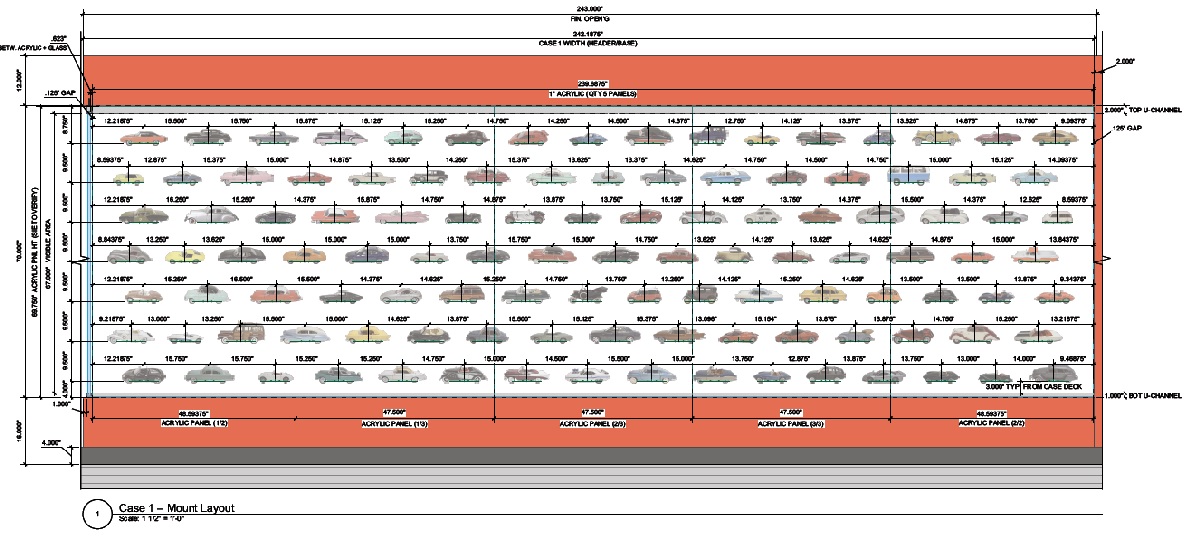
Once the design was complete, it was time to put the pedal to the metal and fabricate and install!



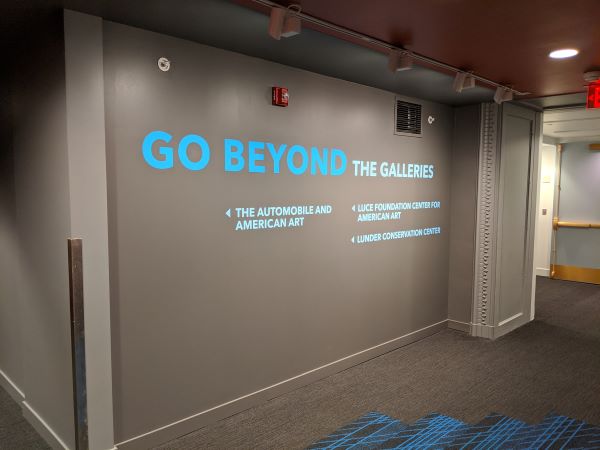
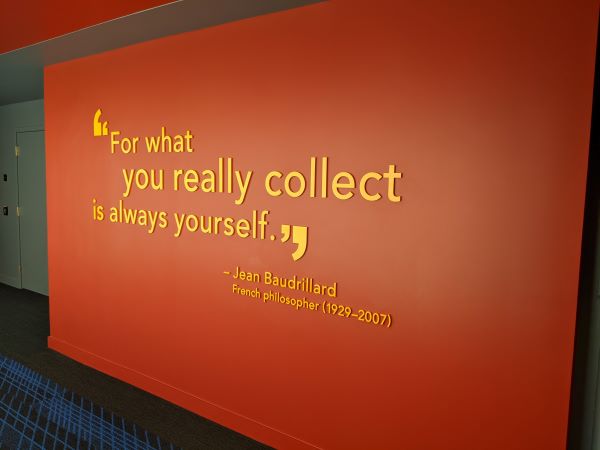
SIE exhibit developer John Powell (yours truly) helped SAAM develop the content for the installation, including a touchscreen kiosk, which takes visitors on a road trip through car-themed American art.

Throughout the project, SIE project manager Rob Wilcox kept the show on the road to success, directing traffic and avoiding any collisions.
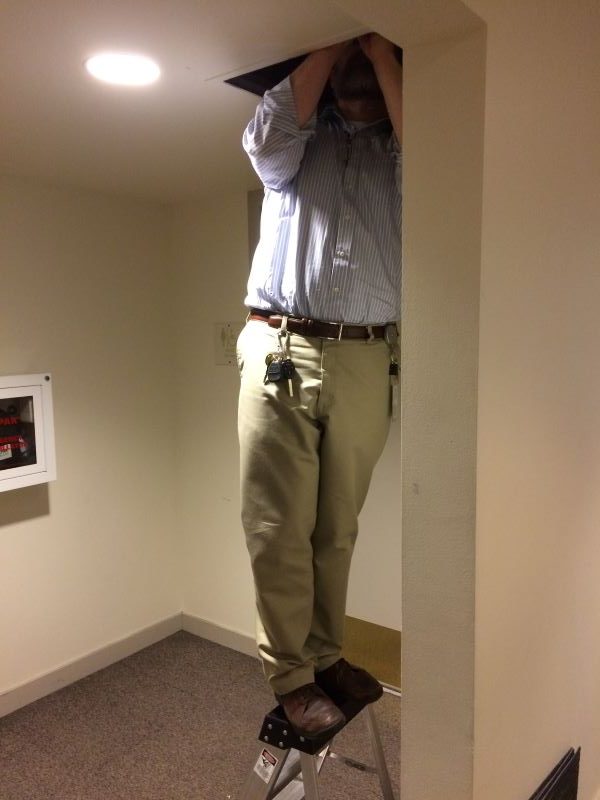
We think you’ll agree that the final result is breathtaking!
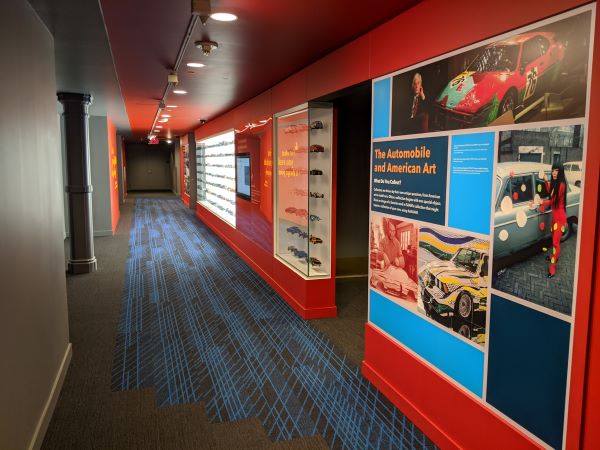


We hope you’ll check out the installation now that SAAM has reopened. Please see SAAM’s website for guidelines on visiting and to reserve a timed-entry pass. Stay safe everyone!


